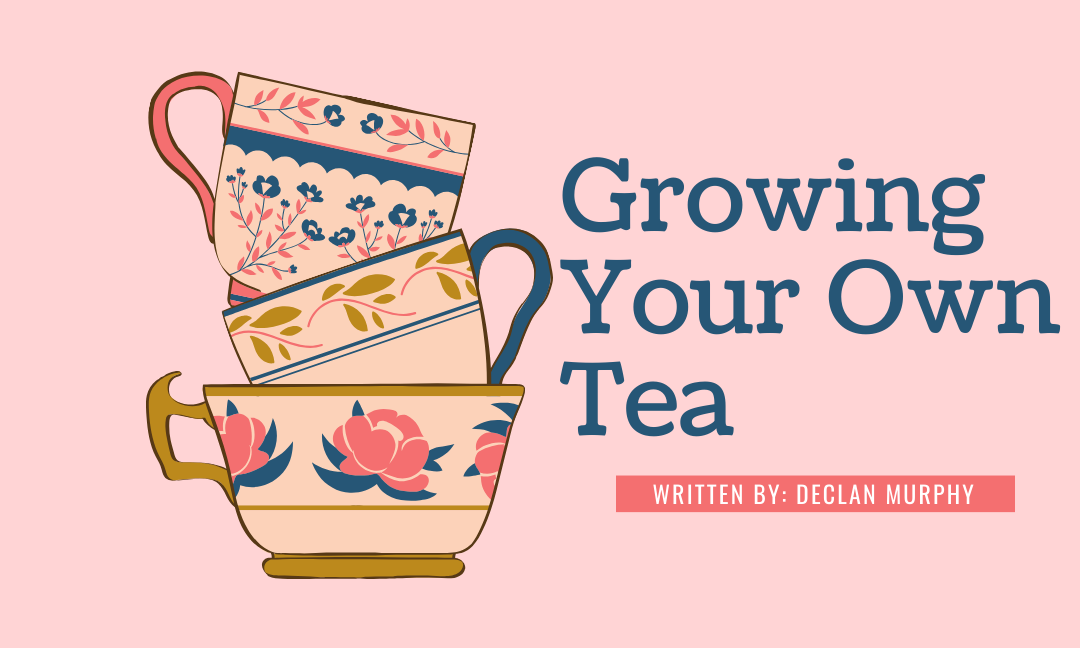Written by Declan Murphy.
Edited by Kiritika Rana.
Designed by Jiya Mehta.
Published by Maryam Khan.
If you love herbal tea, you should consider growing your own – it’s easier than you may think!
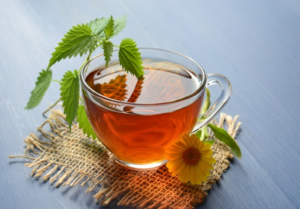
In this post, I will tell you how you can grow a few popular tea herbs (mint, lavender and chamomile), and how you can take them from garden to cup in just a few easy steps, whether you have a sizable outdoor garden or just room for a few potted plants.
Aside from the many potential health benefits, growing your herbal teas can have substantial benefits for your household budget, as well as for the environment.
While gardening at home can require some upfront capital, including the cost of tools and seeds, growing herbs at home generally produces a good yield, giving you a very favourable return on that initial investment. One mint plant can grow up to 2-4’ in one season, making its tea just pennies a cup – even less if you propagate it from a cutting (the best way to start a mint plant), which many gardeners may be happy to share for free!
Furthermore, the environmental impacts of buying tea from the supermarket can be astonishing, even if you choose organic, sustainable teas. Growing your tea eliminates the need for bulky packaging. Using loose tea is especially advantageous over bagged teas, which may seem compostable, but which can contain 20-30% plastic. Skipping the need to transport tea between harvesting and processing, as well as to and from the store, also significantly reduces the carbon footprint of your favourite cuppa.
Growing herbs, especially edible flowers, outside is also beneficial for your immediate surroundings, as they are highly attractive to pollinators and can be cheerful additions to any backyard or balcony.
In many ways, tea herbs are easier to grow than many fruits and vegetables. Herbs generally require less space and many are more drought tolerant. Most herbal tea plants can be content in a patch of ground in the yard, in big pots on the patio or balcony, or even in small pots on a windowsill. They like the natural sun but can flourish under grow lights all winter, as well. Most types will need a good six hours of sunlight per day, though some types of mint do fine in partial shade. They all like sufficient light and water, and to grow in well-draining soil, but what the setup looks like depends on what you have and what you want to do with it.
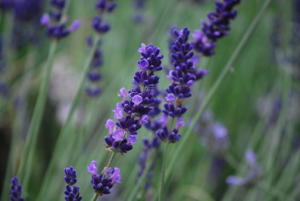
Mint is happy outdoors all summer, and, as a perennial, can be left outdoors in containers or the ground over winter, or brought inside in pots. There are many varieties of mint; most tea drinkers prefer peppermint, spearmint or apple mint, but almost any type can produce a nice cup of tea. Lavender (English Lavender is the kind best grown for tea), though a perennial in Ontario, is a bit more finicky, but can be grown successfully in either containers or gardens. Lavender can be challenging to grow from seed according to the Farmer’s Almanac, and we agree, so ours started as seedlings purchased from an environmentally responsible nursery. Chamomile is an annual and can be started from seed indoors before the start of the growing season, or purchased as starter plants from your favourite greenhouse – as long as they don’t use any pesticides or fertilizers that will make the flowers inedible!
When it’s time to harvest, make sure you have a good, clean pair of garden scissors; this protects both you and the plant, which can get an infection from a dirty cut the same as you can! Most gardeners say that harvesting should be done first thing in the morning before the sun gets too hot. For mint, you should prune your plant regularly by snipping the desired amount of young leaves from the plant as you need them. For chamomile and lavender, you’ll want to harvest the flowers when they are in the bud. Never harvest more than a third of the plant at any one time, so you can enjoy the plant for the whole season and beyond!
Most tea herbs can be used fresh – just wash and bruise the herbs before brewing! However, you may wish to preserve your harvest for future use. Always gently wash and dry the herb before preserving. Many herbalists dry their plants by hanging them upside down, but you can also spread them on a screen, rack or tea towel in a cool, dry place, and turn them regularly for a week or two. Some gardeners dry some plants slowly in the oven, at a low heat (ca. 180F) for two to four hours. If you have a food dehydrator, that is also a great option. When the leaves or flowers are adequately dried, strip them and store them in an airtight glass jar and keep them in a cool, dry place to enjoy all winter.
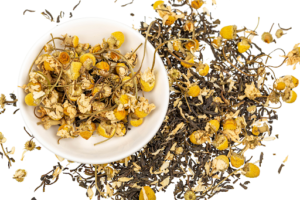
Making tea from mint, chamomile or lavender is a simple infusion process from the flowers or leaves. To infuse tea, you can use a tea ball or an infuser, or simply steep the herbs directly in the pot and pour it into cups through a strainer. You simply pour in the desired amount of hot water and let them steep for the recommended length of time.
When using fresh mint, you will want to bruise one handful of young mint leaves for every two cups of just-boiled hot water, and steep for 5 to 10 minutes. If you are using dried mint, you should try a teaspoon of crushed mint leaf per cup. For lavender, you should try two teaspoons of flower buds, whether they are dried or fresh, for every cup of hot water. Chamomile is about 3 or 4 tablespoons of fresh flowers per cup of hot water, or about a teaspoon of dried.
Remember, the length of time that you steep your tea and the amount of herb you use will make your tea weaker or stronger, and it’s a matter of personal preference which is better, so don’t be afraid to play with the timing and amounts until you find what works best for you!
Once you have mastered the basic tea-making process, feel free to get creative by trying different blends. Chamomile-mint is a great combination, as is chamomile and lavender. For any of these combinations, just use half the amount of one and half the other!
It’s just that simple to have fresh tea during the growing season, as well as dried teas available all winter long!
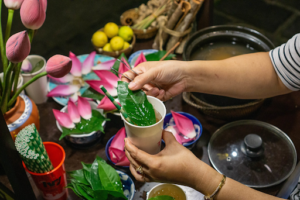
In this post, we have focused on lavender, chamomile and mint, but there’s no end to the varieties of other herb and flower teas you can explore, in infinite combinations, given the space available to you. If you’re ambitious, you could even try fruit and berry teas, or even the non-herbal caffeinated types! Many teas are made using these same basic steps. We recommend you start with these easy ones and work from there. With a little effort, both you and the environment can benefit from your tea garden!
What’s your favourite tea(s)? Please, share in the comments below.
Sources:
Aaron, G. (2021.) 5 Ways to Make Fruit Tea – wikiHow
Almanac. (2023.) How to Grow a Tea Garden (And 10 Herbs to Plant)
Anon. (2023.) From Farm To Cup: The Environmental Impact Of Tea | The Good Boutique
Anon. (n.d.) Image: Potted mint. PxFuel.
Biniarz, A.L. (2022.) Herbs: Delicious to Eat and Beneficial for the Environment
Boeckmann, C. (2023.) Planting, Growing, and Harvesting Mint
Boeckmann, C. (2023.) How to Plant, Grow, and Care for Lavender Flowers | The Old Farmer’s Almanac
Boyles, M. (2023.) Growing Edible Flowers in Your Garden
Boyles, M. (2023.) Brew Yourself a Cup of Chamomile
Cowan, S. (2016.) Grow Your Own Herbal Teas | Eartheasy Guides & Articles
Cumberpatch, F. (2021.) How to grow your own herbal tea: guide to creating a tea garden | Gardeningetc
David, L. (2021.) How to Grow Your Own Tea Garden
Epicnom. (2010.) Image: Lavender (Lavandula angustifolia).
Farrell, A. (2020.) How to Create Your Own Herbal Tea Garden – The New York Times
Goodwin, L. (2022.) Quick and Easy Fresh Mint Tea Recipe
Harvard Health. (2021.) The health benefits of 3 herbal teas
Henry, J. (2022.) Lavender Mint Tea Recipe
Matcha Alternatives. (2020.) Making Your Tea Greener: Environmental impact of teabags, coffee, pack – Matcha Alternatives
McGilvray, J. and M. Francis. (n.d.) 4 Ways to Dry Fresh Herbs
Overhiser, S. and A. (2021.) DIY Lavender Tea – A Couple Cooks
Paajanen, S. (2019.) Grow and Harvest Tea at Home
Pearce, J. (2022.) The Carbon Footprint of a Cup of Tea – Circular Ecology
Pershina, M. (n.d.) Image: Herbal tea in a transparent mug.
Rachel. (2015.) How to Make Chamomile Tea with Fresh Flowers – Simple Seasonal
Rose, S. (2023.) Harvesting Herbs, Healing, and How to Make the Perfect Cup of Herbal Tea – Garden Therapy
Sencha Tea Bar. (n.d.) How to Make Chamomile Tea: 5 Recipes From Simple Tea to a Hot Toddy
Sencha Tea Bar (n.d.) How to Make Peppermint Tea 5 Different Ways
Simple Loose Leaf Tea Co. (n.d.) Top 50 List of Herbal Teas & their benefits, uses
Sweetser, R. (2023.) How to Dry Your Own Herbs for Tea | The Old Farmer’s Almanac
Verch, M. (2021.) Image: Woman preparing Traditional Herbal Tea with Lotus Flowers, Leaves, Lime and Lemongrass in a Paper Cup with Paper Straw in Hoi An, Vietnam.
Verch, M. (2021.) Image: Herbal tea with dried chamomile flowers and black tea, top view.

